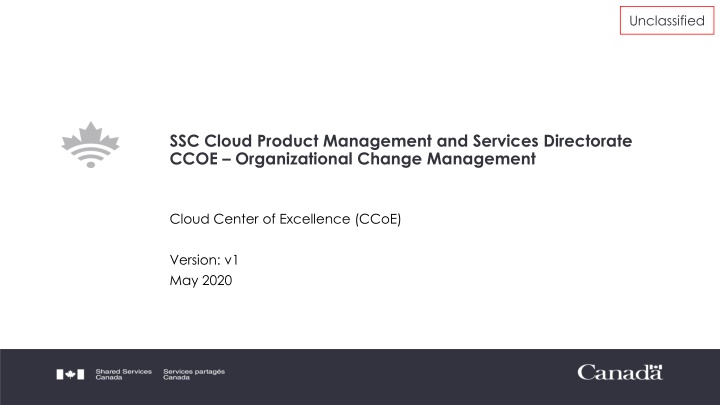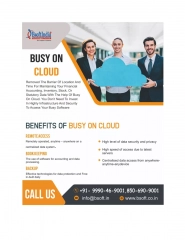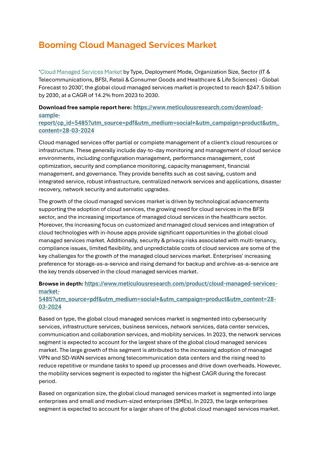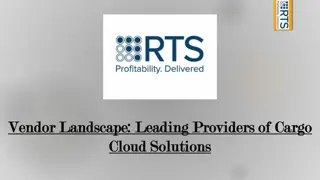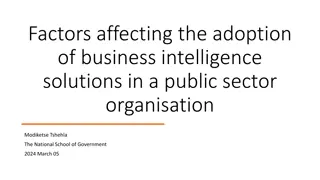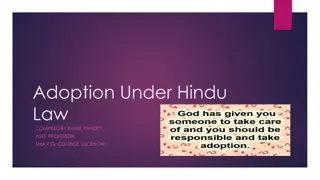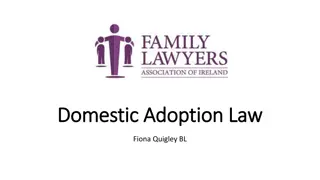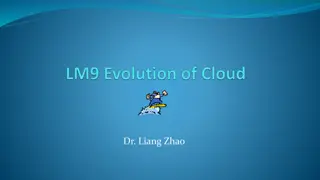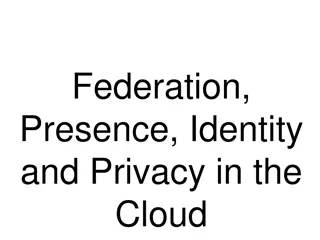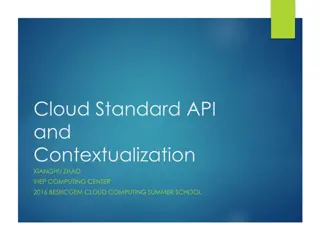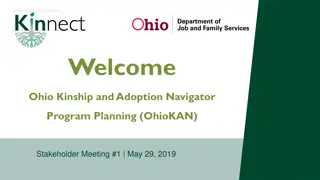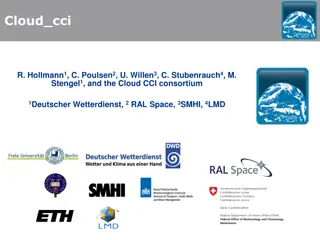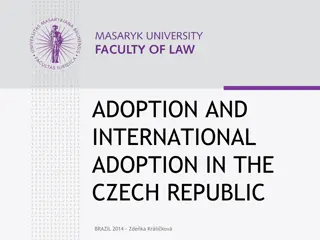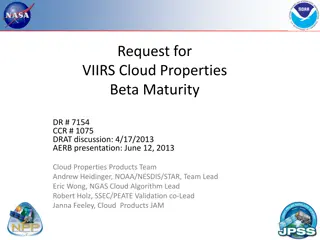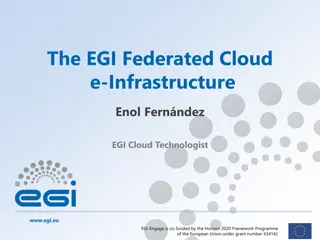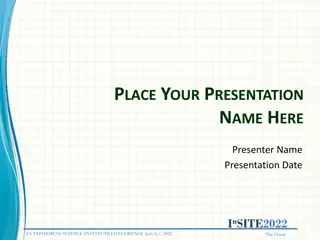Cloud Adoption and Organizational Change Management Program Overview
This document provides insights into the Cloud Center of Excellence (CCoE) and its Cloud Adoption Program alongside details on Organizational Change Management. Key topics include Cloud Readiness Processes, Cloud Governance Establishment, and the iterative nature of Cloud Adoption for application migration. The agenda covers phases such as Change Impact Assessment and Strategy Creation.
Uploaded on Oct 09, 2024 | 1 Views
Download Presentation

Please find below an Image/Link to download the presentation.
The content on the website is provided AS IS for your information and personal use only. It may not be sold, licensed, or shared on other websites without obtaining consent from the author.If you encounter any issues during the download, it is possible that the publisher has removed the file from their server.
You are allowed to download the files provided on this website for personal or commercial use, subject to the condition that they are used lawfully. All files are the property of their respective owners.
The content on the website is provided AS IS for your information and personal use only. It may not be sold, licensed, or shared on other websites without obtaining consent from the author.
E N D
Presentation Transcript
Unclassified SSC Cloud Product Management and Services Directorate CCOE Organizational Change Management Cloud Center of Excellence (CCoE) Version: v1 May 2020
Playbook Audience and Framework Cloud Core Team Audience Cloud Practitioners Audience IT Team Member Audience Executive Audience CIO Cloud CCoE Audience Audience Goal: Goal: Cloud Program Design Goal: Cloud Program Establishment Goal: Cloud Program Deployment Goal: Cloud Program Impl/Ops Goal: Cloud Awareness Engagement and Cloud Program Definition Cloud Adoption Journey Work Load Migration Impl/Ops Cloud Initiation - Cloud Adoption Objectives/KPIs Workshop - Cloud Readiness Assessment Work Load Analysis Establishment Work Load Analysis Execution Foundational Services Impl/Ops Cloud Adoption Program Cloud Governance Establishment Foundational Services Establishment Foundational Services Deployment Cloud Awareness Playbook - Governance Teams - Governance Processes GC Cloud Use Cases and Usage Profiles Cloud Core Services Impl/Ops Cloud Direction - Cloud Services HL Design - Cloud Adoption Roadmap - Organizational Change Management Cloud Core Services Establishment Cloud Core Services Deployment Cloud Program - Program Initiation - Program Evolution Governance Processes Impl/Ops 2
Agenda 1. Cloud Adoption Program Overview 2. Organizational Change Management Overview Context Purpose Impact The Curve Progress 3. Organizational Change Management Phases Change Impact Assessment Change Mgmt Strategy Creation Actions Plan 4. Next Steps 5. Appendix Templates Samples Check Lists 3
Cloud Adoption Program Program Overview
Cloud Adoption Program Overview Cloud Adoption is a program not a project. It does not have a defined end. It continues to evolve indefinitely. Cloud Readiness Processes is the first phase of Cloud Adoption! *Iterative for each new application or workload migration 5
Cloud Readiness Processes The first key phase of a successful Cloud Adoption is the Cloud Readiness Processes. The goal of the Cloud Readiness Processes is to establish the following processes; Cloud Initiation Process Cloud Cloud Direction Creation Governance Establishment 6
Cloud Direction Creation Overview The final process of the Cloud Readiness Processes is Cloud Direction Creation. The Cloud Direction Creation requires definition and alignment on the following; High Level Cloud Services Design High Level Cloud Roadmap Organizational Change Management Initial Cloud Initiatives Create your High Level Cloud Roadmap and associated Adoption Phases. Create your High Level Cloud Services Design and End State view. Create your Organizational Change Management Plan. Identify your Initial Cloud Initiatives. 7
Organizational Change Management Overview Context Purpose Impact The Curve Progress
Organizational Change Management Overview Organizational Change Management is one of the six Cloud Adoption Core Principles that are critical for a successful Cloud Adoption. Organizational Change Management is a process that requires: Organizational Change Management Top Down Support and Commitment Executive and Senior Management Cloud Speed/ Frictionless Governance Security/ Privacy Built In Establish Clear Objectives and KPIs Departmental Business Level Champion the Transition and Provide Guidance Cloud Centre of Excellence (CCoE) Cloud Core Team (CCT) Cloud Adoption Core Principles Self Service /w Extensive Automation Single Pane of Glass Visibility Establish a Clear Communications Plan Educate all members of the organization Multi-Cloud Support Establish a Substantial Training Plan Assist all members of the organization 9
Organizational Change Management Purpose Adopting the Cloud is more than a single event, it is a process, that requires a culture change. The purpose of the Change Management Strategy for this journey is to: Define the key stakeholders & impacted audiences (as per the Stakeholder & Impact Assessment template) Define the extent of impact to stakeholders Describe gaps in knowledge and skills that need to be addressed to meet objectives Outline communications and training strategies Develop and deliver on Action Plans to execute on the Change Management Strategy 10
Organizational Change Management Impact Cloud Adoption impacts audiences from every part of the organization: Finance and Procurement Move from CAPEX to OPEX with different Cloud subscription models to manage on a daily basis to optimize utilization Communications Everyone in the organization needs to understand why it is good for them and have access to information Human Resources Requires hiring of new cloud skills and experienced contractors and extensive cloud training programs for employees. Development The CI/CD pipeline must be fully automated, all test cases must be automated, and all security components must be built-in and security policies adhered to Operations Programs All environment builds must be completely automated as infrastructure-as-code and all changes must be scripted and included in the CI/CD pipeline. Needs to understand the value of the cloud to them and fully embrace the iterative nature of the process QA Security All testing (functionality, security, operational, performance) needs to be automated and occur for every change as part of the CI/CD pipeline Security now must be embedded in the CI/CD process as there is no time for separate security testing 11
Organizational Change Management The Curve Identifying where each audience falls on the curve can indicate where training or communications interventions are required to get audiences where they need to be by the end of the initiative. Act Believe Understand Act is : Aware Long-term, in-depth testing, trial and application of the change. The notion that the new processes are the status quo, not a deviation from it. Where the implementation of the change is past the point of no return Believe is : Understand is : The comprehension of the nature and intent of the change as well as where they fit in Shows signs of buy-in for the Change Demonstrates a willingness to embrace the change in some fashion Test run of new org, process, system or concept Unaware Aware is : Knowledgeable of initiative/change but unclear of the scope, depth, full impact, or rationale for change The realization that they are affected but not sure how Unaware is : Lack of knowledge of the initiative/change Exit Criteria: Speaks positively of the change at an individual and organizational level Participates actively in meetings to discuss the change Exit Criteria: Realizes that the change will affect the status quo without understanding the full impact Exit Criteria: Attempts to implement the change Exit Criteria: Describes the change and the business rationale behind it after active questioning Exit Criteria: This is the status quo 12
Organizational Change Management Progress If all factors are not in place, the chances of successful change are significantlyreduced. Use this grid to track your change progress with each audience. Change Happens See It Own It Live It Clear WIIFM Concrete plan Tools in place Reinfor- cement Case for change Committed leadership SUCCESS! Case for change Committed leadership Clear WIIFM Concrete plan Tools in place Reinfor- cement It s not urgent Case for change Committed leadership Clear WIIFM Concrete plan Tools in place Reinfor- cement It s not real Case for change Committed leadership Clear WIIFM Concrete plan Tools in place Reinfor- cement It s not worth it Case for change Committed leadership Clear WIIFM Concrete plan Tools in place Reinfor- cement It s not going anywhere Case for change Committed leadership Clear WIIFM Concrete plan Tools in place Reinfor- cement It s not possible Case for change Committed leadership Clear WIIFM Concrete plan Tools in place Reinfor- cement It s not for long 13
Organizational Change Management Process Change Impact Assessment Change Mgmt Strategy Creation Action Plans
Organizational Change Management Process Phases The Organizational Change Management process is comprised of the following three main phases; Change Impact Assessment Change Management Strategy Creation Action Plans Defines the strategic approach to successfully deliver the Cloud Adoption program from a people perspective Design, Develop, and Deliver the required Action Plans to implement the Change Management Strategy Understand Cloud Adoption program objectives and scope and identify impact on all stakeholders 15 *See Appendix for Definition and Templates
Change Impact Assessment The first phase in the Organizational Change Management process is the Change Impact Assessment. The Change Impact Assessment phase is comprised of the following tasks: Understand Objectives and Scope Identify Change Vision Identify Benefits and Challenges Identify the expected outcomes of the change on the Department as a whole in terms of how it functions internally as well as how it delivers its services externally Ensure alignment on the Departmental Business Objectives and KPIs as well as Program scope in terms of impacted audiences for Cloud Adoption Identify the benefits and challenges of the Cloud Adoption Change for the Department as a whole. Identify Detailed Impacted Audiences Audience Analysis For each impacted Audience, meet with them to identify required changes to transition to Cloud and analyze the impact level and impacts of each change. Identify Cloud Adoption Change Sponsors, Stakeholders, and all Audiences (existing and new) impacted by the Change. 16
Change Management Strategy The next phase in the Organizational Change Management process is the Change Management Strategy Creation. The Change Management Strategy Creation phase is comprised of the following tasks: Communications and Engagement Identifies the purpose of all required Communications and defines how the program will communicate to its stakeholders and audiences. Sponsorship Training Identifies how the Program Sponsor will drive the change to stakeholders and impacted audiences. Identified the required Training Programs and defines how the Program will train the users that need to acquire new skills User Support Acceptance Identifies the required User Support and defines how end users will receive ongoing support regarding their tasks and roles Identifies the Program Acceptance Criteria and defines how the program will ensure that the plans are successfully adopted 17
Change Management Action Plans The final phase in the Organizational Change Management process is the Action Plans. The Action Plans phase is comprised of the following tasks: Design Action Plans Design Actions Plans to implement the Change Management Strategy for all required audiences in Sponsors and Stakeholders (i.e.. Communications Plans, Training Plans, User Support Plans, etc.) Develop Action Plan Deliver Action Plans Evaluate and Improve Develop Action Plan Materials to implement the Change Management Strategy for all required audiences.(i.e.. Communications Material, Training Materials, User Support Material, etc.) Deliver Action Plans to all required audiences to implement and Change Management Strategy. (i.e.. Communications, Training, Support, etc.) Ongoing evaluation and improvement of the Change Management Strategy and associated Action Plans against the Acceptance Criteria. 18
Next Steps in your Cloud Journey Now that you understand Organizational Change Management and the steps to create and execute a Change Management Strategy, You are ready to take your next steps in your Cloud Journey! Collect Departmental Cloud Adoption Business Objectives and KPIs outputs Engage Communications Team to Lead this process Have Communications engage the CCoE to initiate the Impact Assessment Engage Additional Audiences as required to complete Impact Assessment Perform Change Impact Assessment Have Communications lead the creation of the Change Mgmt Strategy Engage Sponsors, Training, and Support Teams to validate required programs Present Change Mgmt. Strategy to CCoE and Cloud Exec for Approval Create Change Management Strategy Have Communications lead the execution of the Change Mgmt. Strategy Validate Action Plans and Action Plan Materials with the CCoE Schedule Action Plan Delivery in co-ordination with CCoE and CCT Delivery of Cloud Services Feed Improvement Plans into CCoE for approval Design, Develop, and initiate Delivery of Change Action Plan 19
Sponsorship Definition Sponsoring Change Involves: Being visible, active, vocal, fully involved in project activities, and relentless in communications Showing personal belief that the future state is worth the price of the transition Executive sponsorship is critical; a leadership coalition is also critical. Having other leaders within the organization advocate and sponsor the change is equally important in driving change The Sponsorship role fulfills the following responsibilities: For the Initiative/Project: Obtain project resources Promote change to audience and stakeholders Build and maintain project momentum and leadership support For Employees: Maintain employee focus and effort on the change Continuously promote understanding by clarifying the change goals and benefits Continuously reinforce the change through recognition and acknowledgement 21
Stakeholders & Impacted Audiences Assessment Definitions Stakeholders Impacted Audiences Those who are directly impacted by the change (e.g., individuals who need to change how they do something a change in process, a change in responsibility, a change in technology, or a change in how they fit within an organization - a change in role, change in team). Impacts can range from Low to High. Low Impact Medium Impact Those who have a vested interest in seeing the change successful or who might be affected by the outcome of the change. Sponsors Individuals who are in a governance role Individuals who commit funds Individuals who may see downstream affects of the change Individuals who need to understand the change High Impact Indirect impact Limited to no job or responsibility changes Minor process and/or technology change Limited culture change Overall job responsibilities will change less than 10% Direct impact Moderate job or responsibility changes Moderate process and/or technology change Moderate culture change Overall job responsibilities will change by 10-50% Direct impact Significant job or responsibility changes Significant process and/or technology change Significant culture change Overall job responsibilities will change by 50-100% 22
Stakeholders Identification Template Stakeholder Role description and current situation/responsibilities Role: Situation: [Stakeholder Name] Role: Situation: [Stakeholder Name] Role: Situation: [Stakeholder Name] Role: Situation: [Stakeholder Name] Role: Situation: [Stakeholder Name] 23
Cloud Adoption Change Vision Technology Today To Be Vision Current Mode of Operations Expected Outcomes from Cloud Adoption 24
Stakeholders & Audience Impact Assessment Template [Audience Name] Description Stakeholder/Audience Description. As Is Current mode of Operation. To Be New mode of Operation with Cloud. Audience: High Impact Audience Segments that are highly impacted. Audience: Medium Impact Audience Segments that are moderately impacted. Audience: Low Impact Audience Segments that are minimally impacted. Audience Characteristics: Define # of individual in each group Describe other characteristics of interest Assumptions/Risks/Comments: Notes on your assumptions, etc.. 25
Communication Plan Guidelines No communication program will be successful if it is only driven by the initiative/project team. Respected and well-positioned communicators will be used to convey the necessary messages and take ownership. Face-to-face events with the impacted stakeholders are the most effective away to gain involvement and provide an opportunity for feedback. These events can also be used to sell the benefits of the program. Ownership and Involvement It is vital that senior management is committed to the success of the initiative. What they do is more important than what they say. Communication items and events should be created that provide opportunities for people to observe this commitment. Need to find appropriate balance between creating awareness/ensuring engagement and managing expectations Commitment Mass communications rarely change people s beliefs or behaviours. Due to the scope of the initiative, a key aspect will be to engage representatives of impacted groups early and often. This will ensure that an increasing number of communications are face-to-face and/or sent by Managers/Supervisors. This has been shown to be one of the most effective communication methods. Involve Stakeholders Where feasible, communication materials should have a consistent look and feel carried through all materials (exceptions include Intranet content). This provides a sense of consistency and initiative recognition for the audience and will improve the visual impact of all initiative communication. This may include the use of a logo or other branding items that contribute to a strong sense of purpose and pride in the initiative. Strong Visual Style/Identity A broad-band approach will be used to get messages out to large audiences. Most messages communicated will be customized to each target audience segment so information is relevant and communicates the desired change in beliefs or behaviours. The messages should answer the key questions: What does it mean for me? and What is my role? All communication must deliver realistic messages and be consistent and easy to understand. Tailored Messages & Broad-band communications 26
Communication Plan Guidelines Cont. Communication items and events help stakeholders form an opinion of the initiative and should be of the highest quality. A quality-based review process and high-quality production will ensure that communication materials and events reflect the high standards of the initiative. Quality In order to maintain an accurate picture of whether or not key messages are reaching the target audience, feedback will need to be collected on a timely basis. A series of formal and informal feedback mechanisms are required such as structured questionnaires, face-to-face interviews, and direct links with team briefings. Information should only be gathered where actions will be taken based on the results. Measurement and Evaluation Communications must be timed appropriately and be relevant to the target audience. Too much communication too early is counterproductive. Employees become saturated and then disregard more important messages closer to change . Relevance & Timing Push communications (e-mails, voice mails) will be sent out when new information is posted on the intranet site, when information is time-sensitive, or if the message is urgent or critical, etc. Pull communications will be used for complex or detailed information that the user requires/must know. Push communications can also be used as teasers (e.g., go to web site to find out details). Push vs. Pull Communications Reward & Recognition It is important to recognize when impacted audience groups meet readiness and acceptance goals. Also other critical players should be recognized by Managers and initiative executives for meeting targets. 27
Communications Plan Template Communication Vehicle Target Audience Sender Timing 28
Communications Material - Awareness Campaign Template Internal Impacted Audiences Key Messages business reasons for Cloud details about Cloud impact of the Cloud roles and responsibilities of senior managers and executives how the development is happening and progressing Messages for senior managers and executives business reason for Cloud details about the Cloud how the initiative is being implemented impact of the new system on managers roles and expectations for managers and supervisors how managers and supervisors will be prepared and supported Messages for managers and supervisors business reason for Cloud necessity to ensure organizational success and sustainability role of the new system in support of business initiatives and strategies risks of not changing to a new system (impacts, consequences) benefits of the Cloud: improvements to processes, operations and design enhancements details about the Cloud how the initiative is happening impact of the Cloud on the employee why employees should want to participate (WIIFM) explain how the new system aligns with employee priorities indicate potential opportunities how the Cloud will increase the quality of their work life demonstrating how it will make their job easier, more efficient, more productive, and less redundant provide testimonials and examples of where the new system was successful elsewhere how employees will be supported through the project what they will need to be prepared resources that are made available to help them with the transition information pertaining to how and when employees will be trained where to go for information Messages for employees 29
Change Management Activities Roadmap - Template Q1 Q2 Q3 Q4 Communications & Training Sponsor Messaging *CIO Roadshow Nov 18-22 CIO Blog / Newsletter CIO CIO Blog / Newsletter CIO Blog / Newsletter CIO Blog / Newsletter Road Show* Cloud Series Success Intro Roles Topic 5 Topic 6 Topic 4 Training Opportunities More Advanced topics.. More Advanced topics.. Cloud 101 DevSecOps Client Engagement Process Topic Topic Intro Cloud Knowledge Base 30
Organizational Change Management Impact & Strategy Checklist Phase Tasks Identify Document Validate Change Impact Assessment Understand Objectives and Scope Identify Change Vision Identify Benefits and Challenges Identify Impacted Audiences Detailed Audience Analysis Change Management Strategy Communications and Engagement Sponsorship Training User Support Acceptance 31
Organizational Change Management Action Plan Checklist Content Develop Evaluate and Improve Action Plan Plan Design Plan Delivery Communications Plan Sponsorship Plan Training Plan Support Plan 32
